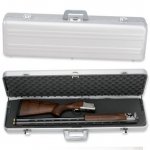I always wondered though, if your case is airtight and you are in a very humid place when you close it, how much of that humidity is trapped in the case when you close it with no way out.
But I hope that this shows you that we are thinking about it and doing what we can to protect against moisture. I have thought about this a lot over the years and although I still believe that it's mostly up to the cue's construction how well it handles moisture I do agree that a case can help to protect the cue against the effects of moisture if it's built with that in mind.
When I buy cases, I think about a good seal. Like JB described in his post, it is not about keeping the humidity out but a matter of keeping it relatively stable. Sure, aged wood from custom cue makers will be more resilient to the affects of constant changing climates, but whatever we can do to stabilize those conditions will help to improve and lengthen the life of the cue.
Earlier this year I purchased a 27 year old cue from the original owner who happened to reside in Florida. At the time he bought the cue, he decided to put it inside of an Adams case. These cases, though cheaply made, have a relatively decent seal. I had the cue refinished in October and was told by the cue maker that the cue was the dead straightest he had ever worked on for its age to come from Florida. I was both shocked and relieved to hear that!
Most cues are sealed over the largest portion of their surface, maybe 95% or more. A careful cue maker may have it fully sealed. The parts that aren't sealed in some cues are carefully fitted and probably less likely to pass humidity than a case. For example a weight bolt and the bumper over it may be into raw wood that isn't sealed. Obviously there still isn't much actual exposure to open air.
Considering how long it will take humidity and temperature to stabilize in the outside air and in a cue case is worthwhile but isn't the primary thing that should control moisture in a cue. If a cue isn't sealed to begin with it will be moving around every time it is played with and the least of it's woes will be the brief time it is subjected to different conditions inside a case.
If the cue is wrapless, then yes it is sealed nearly 90% excluding the shafts. Shafts are the first to warp since they are mostly exposed wood. Most cues when introduced to humidity and temperature changes warp around the linen wrap of the handle. This is where the cue handle is least protected. It is often times bare wood with some Elmer's glue underneath the linen wrap. Elmer's glue is not very moisture resistant. Moisture absorbs into the linen and then into the wood afterward.
I don't think its a matter of controlling the moisture in the cue, its a matter of keeping the cue in as stable of an environment that does not change too often nor too quickly. The sharp changes in humidity and/or temperature will cause the wood to expand and contract. With that expansion and contraction, the wood will want to move in the direction of what its natural fibers pull it toward. That is why you won't know what direction it'll warp if subjected to harsh condition. A cue case should help minimize this affect as best as possible. At least, that is what would be ideal.
The cork type cap is made from EVA foam that we cut with the laser. This method works for all tube sizes. We can do the same with wood.
What I think I want to do is develop a lid that seals but at the same time preserves the capacity inside the case.
When I get home I will be doing more development on this.
Out of curiosity, but when I think of foam then I wonder of longevity. I understand that memory foam product in general normally have a 15 year warranty, would that amount to the time it takes for the foam material to become brittle and dry out? I'm thinking about this based on how standard form would become brittle and fall apart after a certain age.
